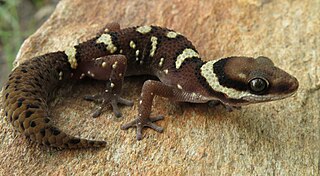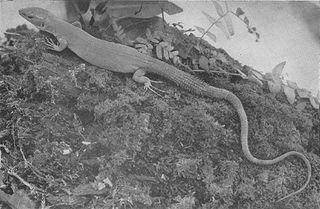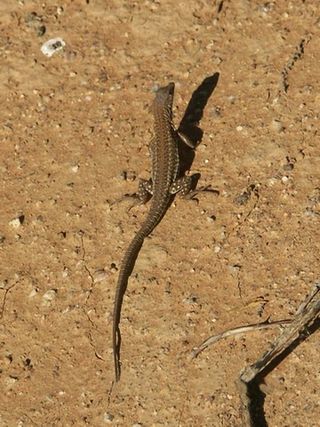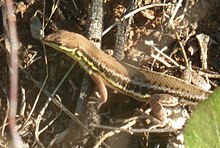
Pachydactylus is a genus of insectivorous geckos, lizards in the family Gekkonidae. The genus is endemic to Africa, and member species are commonly known as thick-toed geckos. The genus also displays rich speciation, having 57 distinct species identified when compared to other closely related gecko genera like Rhoptropus, most of which have emerged since 35Ma. It has been suggested that the reason for this rich speciation not from adaptive radiation nor nonadaptive radiation, but that the genus represents a clade somewhere between the two drivers of speciation. P. bibronii geckos have been used by NASA as animal models for experimentation.

Ptenopus is a small genus of lizards, known commonly as barking geckos, in the family Gekkonidae. The genus is endemic to southern Africa. There are only three described species in this genus.

Gastropholis is a genus of Equatorial African lacertid lizards of the family Lacertidae which is distributed in southern Liberia, Ivory Coast and Ghana, western Cameroon, Equatorial Guinea, Democratic Republic of Congo, eastern Kenya, Tanzania and south to northeastern Mozambique.

Holaspis is a genus of equatorial African lizards in the family Lacertidae. These lizards are capable of gliding flight for distances of 30 meters.

Ichnotropis is a genus of African lizards in the family Lacertidae. Species in the genus Ichnotropis are commonly called rough-scaled lizards.

Meroles is a genus of lizards, commonly known as desert lizards, in the family Lacertidae. The genus contains eight species, inhabiting southwestern Africa, especially the Namib Desert.

Philochortus is a genus of lizards of the family Lacertidae. Species of this genus are distributed in Egypt, Algeria, Libya, Mali, Niger, Ethiopia, Djibouti, Eritrea, Somalia, Kenya, Yemen, and Saudi Arabia.

Pseuderemias is a genus of lizards of the family Lacertidae. Common names for the genus are false sand lizards or racerunners.

The Indian fringe-fingered lizard, also known commonly as the Indian fringe-toed lizard, is a species of lizard in the family Lacertidae. The species is endemic to Asia.

The Cape file snake is a species of large, non-venomous snake endemic to Africa, belonging to the family Lamprophiidae.

Bosc's fringe-toed lizard or Bosk's [sic] fringe-fingered lizard is a species of lizard in the family Lacertidae. The species is endemic to North Africa and Western Asia. Three subspecies are sometimes recognised; A. boskianus boskianus, from Lower Egypt; A. boskianus euphraticus from Iraq; and A. boskianus asper from the rest of the range; however this division is unsatisfactory because each subspecies has much variation and the differences between them are not consistent.

Nucras tessellata, also known as the western sandveld lizard, striped sandveld lizard, tiger lizard, striped sand lizard or banded sand lizard, is a species of lizard in the family Lacertidae. It is native to western Southern Africa and is found in western South Africa, southwestern Botswana, and southern and central Namibia north to Khomas Highland. Its range includes several protected areas, including Tankwa Karoo National Park and ǀAi-ǀAis/Richtersveld Transfrontier Park.

Meroles squamulosa is a species of African lizard originally placed in the genus Ichnotropis, however phylogenetic evidence moves this species to the genus Meroles. The species is commonly called the common rough-scaled lizard or savanna lizard. It is largely found in southern Africa. These lizards are terrestrial and found in the range of mesic savannah. The common rough-scaled lizard is medium in size and well distributed in parts of Namibia, Botswana, Zimbabwe, Angola, Tanzania, and Zambia.
Ichnotropis grandiceps is a species of African lizards in the family Lacertidae. They are commonly called Caprivi rough-scaled lizards as they are largely found in southwestern Africa on the border of the Caprivi Strip. The cape rough-scaled lizards are terrestrial and found in the range of open woodland and mesic savanna. The caprivi rough-scaled lizards are medium in size and distributed in parts of Namibia and Botswana. This species is on the International Union for Conservation of Nature's Red List for endangered species as they are rare and has not been seen or collected since 1998. Data about the population or specimens collected are needed for the IUCN to obtain more information about the unknown threats that may be impacting them.
Ichnotropis microlepidota is a species of African lizard in the family Lacertidae. It is commonly called Marx's rough-scaled lizard and is largely found in Angola, Africa. I. microlepidota is a terrestrial lizard and was first discovered at the foot of Mount Moco.

Congolacerta is a genus of equatorial African lacertids of the family Lacertidae. Species of this genus are distributed in western East Africa.

Duméril's fringe-fingered lizard is a species of lizard in the family Lacertidae. A. dumerilii is in the A. scutellatus species group. A. dumerilii is native to the western and central Sahara.
Monopeltis capensis, also known commonly as the Cape spade-snouted worm lizard, the Cape wedge-snouted worm lizard, the Cape worm lizard, and the South African shield-snouted amphisbaenian, is a species of amphisbaenian in the family Amphisbaenidae. The species is native to southern Africa.
Ichnotropis chapini is a species of lizard in the family Lacertidae. The species is native to Central Africa.















